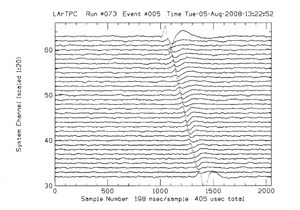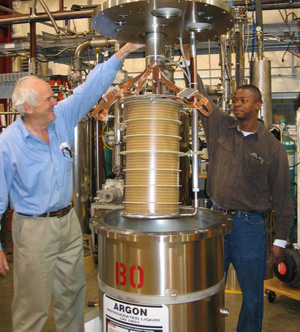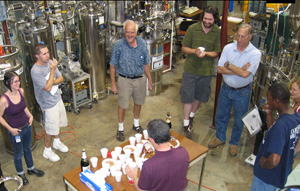First particle tracks seen in liquid-argon detector
 |
| The liquid-argon time projection chamber saw its first particle tracks Aug. 5. This graph shows the electric pulse caused by a cosmic ray crossing the chamber.
|
 |
| Hans Jostlein (left) and Kelly Hardin prepare the liquid-argon time projection chamber for lowering into Bo, the cryostat.
|
 |
| Standing next to the test stations called Bo (far right) and Luke (middle), collaborator Stephen Pordes (foreground) and his colleagues gathered for an impromptu celebration of the first particle tracks.
|
Last week, scientists at Fermilab recorded for the first time tracks of charged particles using a small time-projection chamber filled with liquid argon. The LAr TPC is a promising technology that perhaps could allow for the construction of large, cost-effective detectors for future neutrino experiments.
"It's a significant step for the liquid argon program at Fermilab," said Stephen Pordes, who leads the small team of people working on Bo, the liquid argon electronics test station, and Luke, the liquid argon materials test station. Fermilab engineer Terry Tope, who designed the cryogenics systems for Bo and Luke, named the two test stations after the cousins in the "Dukes of Hazzard," a U.S. TV series from the 1980s set in Georgia. The cryostats, which keep the liquid argon in the two test stations at a temperature of 87 Kelvin, came from a company in Georgia.
Cary Kendziora and his crew of technicians assembled the test stations. "They did a beautiful job," said Tope. "It's great craftsmanship."
After receiving safety approval on Aug. 1, the team filled Bo with liquid argon for the first time on Monday, Aug. 4.The next day the team recorded its first tracks of cosmic rays.
Bo contains a cylindrical time projection chamber that is 50 cm high and 20 cm in diameter. Electrons knocked loose by charged particles traveling through the liquid argon inside the chamber drift along an electric field towards three wire planes at the top of the chamber. One of the major challenges that Kendziora and Tope met was to remove any impurities in the liquid argon, such as oxygen, that would absorb those electrons before they reach the wire planes.
Another major challenge was the design of the electronics to amplify and record the signals received by the wire planes.
"When you are looking for an electrical signal caused by 20,000 electrons hitting a wire, you have to be concerned about electrical noise," said Carl Bromberg, a physics professor at Michigan State University. "That's the major difficulty: to get a good signal-to-noise ratio. On each wire, we expect the noise to be 1,000 electrons." Dan Edmunds and Philippe Laurens both of MSU provided the electronics and the data-acquisition system, which "worked flawlessly," according to Pordes.
The members of the liquid argon group profited from the experience gained by the ICARUS experiment at the Gran Sasso National Laboratory in Italy. For several years, the group exchanged ideas with the ICARUS collaboration. Italian physicists have worked on LAr TPC detectors for more than 20 years, and the ICARUS collaboration will start up its detector, which uses 600 tons of liquid argon, later this year.
Ultimately, scientists at Fermilab hope to build neutrino detectors that are many times larger than ICARUS to reveal the role that neutrinos play in the universe.
David Finley, who helped to coordinate the LAr TPC efforts at Fermilab said: "Now we have the means to develop electronics and test materials for a future, very large liquid-argon detector."
-- Kurt Riesselmann
|